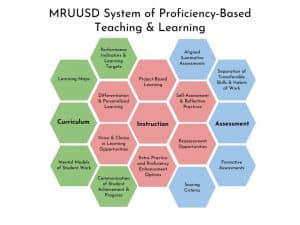Transparency: Operating with a Clear Instructional Vision to Put Policy into Practice
CompetencyWorks Blog

This is the first in a three-part series from Andrew Jones, director of curriculum at Mill River Unified Union School District in Vermont.
Mill River Unified Union School District (MRUUSD) is a small, rural district located in southwest Vermont. Made up of four K-6 schools and one 7-12 union middle/high school, MRUUSD, like most districts in Vermont, is actively engaged in the implementation of proficiency and personalized learning practices. Act 77 and the Educational Quality Standards (EQS), enacted in 2013 and 2014 respectively, are state policies that require elements of personalized learning and proficiency-based learning, including the provision that high school students earn their diplomas based on proficiency and not credits starting with the graduating class of 2020. Mill River School District has embraced these policies as an opportunity to improve student outcomes while simultaneously providing more equitable experiences for all students. Framing our work toward proficiency is a district instructional vision.
A central element of proficiency-based learning is transparency with student expectations, which is why the development of proficiencies took center stage at the start of our implementation process. Modeling the philosophy of transparency and clarity, a set of educator specific proficiencies and performance indicators were drafted (with teacher input) to guide the overall implementation of proficiency-based learning. (See Principle #12 in Quality Principles for Competency-Based Education on page 81 for more information on Transparency.) The performance indicators and associated scoring criteria spell out what it is that teachers are aiming for and what proficiency looks like in each area. Additionally, these proficiencies and performance indicators also informed the development of our multi-year implementation timeline. All of this has helped to create a high level of coherence in an otherwise complex reform environment. (Link to MRUUSD Educator Proficiencies.)
Having a clear instructional vision is absolutely essential. For MRUUSD, this is defined by our set of educator proficiency and performance indicators. The term “instructional vision” can hold a number of connotations, but we see it as our goal post for proficiency. This is what drives the instructional choices that teachers make in their classrooms and gives them a roadmap of sorts as they shift toward a system of proficiency-based learning. Teachers need to see how the system works in addition to the separate parts. Just as we provide students with learning targets and performance indicators, teachers also need checkpoints and goal posts. A defining feature of the educator proficiencies is that they are NOT currently part of the formal supervision and evaluation system. This allows teachers to take risks and innovate without worrying about being “monitored.” At some point, teachers will be expected to be “proficient with proficiency,” but in the meantime the focus is on educator learning and continuous improvement.
This instructional vision was not dreamed up in the central office, but collaboratively crafted with classroom teachers.
This instructional vision was not dreamed up in the central office, but collaboratively crafted with classroom teachers. At MRUUSD, the director of curriculum works closely with the district “Instructional Vision Team” (IVT). Instructional Vision Team members represent teachers from a wide variety of grade levels, schools, and content areas. Currently, we have eighteen teachers on the team. The Instructional Vision Team is a critical resource for gaining input on issues, vetting documents/plans, and generally providing “on the ground” feedback on what is working (or not) in classrooms. In addition to attending regular meetings and providing input on district level decisions, IVT members also help facilitate discussions and lead workshop sessions during district inservice days. The IVT allows teachers to have a voice in district level decision making and an opportunity to develop their leadership expertise. (See Principle #5 on page 48.) Furthermore, the members of the Instructional Vision Team are a critical resource to the director of curriculum and other central office administrators.
Though we still have a ways to go at MRUUSD to be fully proficiency-based, we have, in just a few short years, made significant headway. The north star of our work is the clearly delineated “educator proficiencies” (see link above) that defines our district instructional vision. Additionally, these proficiencies and performance indicators inform our professional development offerings to support teachers as they change their instructional practices.
Read the Entire Series:
- Part 1 – Transparency: Operating with a Clear Instructional Vision to Put Policy into Practice
- Part 2 – Supporting Teachers with Making Sense of Proficiency-Based Learning
- Part 3 – Providing Flexible Pathways and Personalized Learning Options for All Students
Andrew Jones is the director of curriculum for Mill River Unified Union School District (MRUUSD) in North Clarendon, Vermont. Twitter: @AlpinistAndrew
